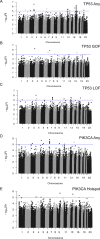Association of ESR1 Germline Variants with TP53 Somatic Variants in Breast Tumors in a Genome-wide Study
- PMID: 38836758
- PMCID: PMC11210444
- DOI: 10.1158/2767-9764.CRC-24-0026
Association of ESR1 Germline Variants with TP53 Somatic Variants in Breast Tumors in a Genome-wide Study
Abstract
In breast tumors, somatic mutation frequencies in TP53 and PIK3CA vary by tumor subtype and ancestry. Emerging data suggest tumor mutation status is associated with germline variants and genetic ancestry. We aimed to identify germline variants that are associated with somatic TP53 or PIK3CA mutation status in breast tumors. A genome-wide association study was conducted in 2,850 women of European ancestry with breast cancer using TP53 and PIK3CA mutation status (positive or negative) as well as specific functional categories [e.g., TP53 gain-of-function (GOF) and loss-of-function, PIK3CA activating] as phenotypes. Germline variants showing evidence of association were selected for validation analyses and tested in multiple independent datasets. Discovery association analyses found five variants associated with TP53 mutation status with P values <1 × 10-6 and 33 variants with P values <1 × 10-5. Forty-four variants were associated with PIK3CA mutation status with P values <1 × 10-5. In validation analyses, only variants at the ESR1 locus were associated with TP53 mutation status after multiple comparisons corrections. Combined analyses in European and Malaysian populations found ESR1 locus variants rs9383938 and rs9479090 associated with the presence of TP53 mutations overall (P values 2 × 10-11 and 4.6 × 10-10, respectively). rs9383938 also showed association with TP53 GOF mutations (P value 6.1 × 10-7). rs9479090 showed suggestive evidence (P value 0.02) for association with TP53 mutation status in African ancestry populations. No other variants were significantly associated with TP53 or PIK3CA mutation status. Larger studies are needed to confirm these findings and determine if additional variants contribute to ancestry-specific differences in mutation frequency.
Significance: Emerging data show ancestry-specific differences in TP53 and PIK3CA mutation frequency in breast tumors suggesting that germline variants may influence somatic mutational processes. This study identified variants near ESR1 associated with TP53 mutation status and identified additional loci with suggestive association which may provide biological insight into observed differences.
© 2024 The Authors; Published by the American Association for Cancer Research.
Figures


Update of
-
Association of ESR1 germline variants with TP53 somatic variants in breast tumors in a genome-wide study.medRxiv [Preprint]. 2023 Dec 6:2023.12.06.23299442. doi: 10.1101/2023.12.06.23299442. medRxiv. 2023. Update in: Cancer Res Commun. 2024 Jun 27;4(6):1597-1608. doi: 10.1158/2767-9764.CRC-24-0026. PMID: 38106140 Free PMC article. Updated. Preprint.
References
Publication types
MeSH terms
Substances
Supplementary concepts
Grants and funding
- v203477/Z/16/Z/Wellcome Trust (WT)
- R01 CA215151-01/HHS | NIH | National Cancer Institute (NCI)
- R01CA228156/HHS | NIH | National Cancer Institute (NCI)
- R01 CA184585/CA/NCI NIH HHS/United States
- Scientex Foundation
- R01 CA228198/CA/NCI NIH HHS/United States
- P30CA033572/HHS | NIH | National Cancer Institute (NCI)
- R01CA184585/HHS | NIH | National Cancer Institute (NCI)
- P30 CA068485/CA/NCI NIH HHS/United States
- MR/P012930/1/Newton-Ungku Omar Fund
- Estée Lauder Companies
- R01 CA202981/CA/NCI NIH HHS/United States
- Yayasan PETRONAS
- OSU CCC Creates
- OPR18111/California Initiative to Advance Precision Medicine
- R01CA164974/HHS | NIH | National Cancer Institute (NCI)
- U24 CA274159/CA/NCI NIH HHS/United States
- Yayasan Sime Darby (YSD)
- U24 CA232979/CA/NCI NIH HHS/United States
- P30CA068485/HHS | NIH | National Cancer Institute (NCI)
- U01 CA164974/CA/NCI NIH HHS/United States
- K24CA169004/HHS | NIH | National Cancer Institute (NCI)
- Morris and Horowitz Families Professorship
- R01MD013452/HHS | NIH | National Institute on Minority Health and Health Disparities (NIMHD)
- U24CA232979/HHS | NIH | National Cancer Institute (NCI)
- R01 MD013452/MD/NIMHD NIH HHS/United States
- U24CA274159/HHS | NIH | National Cancer Institute (NCI)
- P30 CA016058/CA/NCI NIH HHS/United States
- R01 CA228156/CA/NCI NIH HHS/United States
- P30 CA033572/CA/NCI NIH HHS/United States
- WT_/Wellcome Trust/United Kingdom
- R01CA228198/HHS | NIH | National Cancer Institute (NCI)
- R01 CA255242/CA/NCI NIH HHS/United States
- K24 CA169004/CA/NCI NIH HHS/United States
- Pelotonia
- R01CA255242/HHS | NIH | National Cancer Institute (NCI)
- R01 CA215151/CA/NCI NIH HHS/United States
- R01CA202981/HHS | NIH | National Cancer Institute (NCI)
LinkOut - more resources
Full Text Sources
Medical
Research Materials
Miscellaneous

